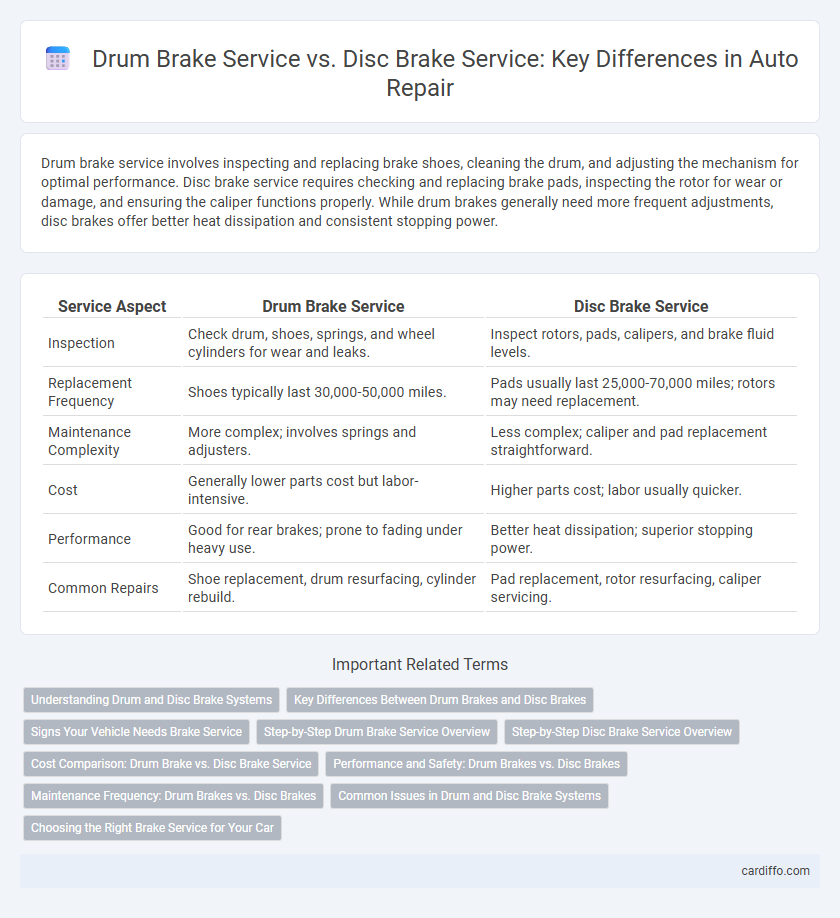Drum brake service involves inspecting and replacing brake shoes, cleaning the drum, and adjusting the mechanism for optimal performance. Disc brake service requires checking and replacing brake pads, inspecting the rotor for wear or damage, and ensuring the caliper functions properly. While drum brakes generally need more frequent adjustments, disc brakes offer better heat dissipation and consistent stopping power.
Table of Comparison
| Service Aspect | Drum Brake Service | Disc Brake Service |
|---|---|---|
| Inspection | Check drum, shoes, springs, and wheel cylinders for wear and leaks. | Inspect rotors, pads, calipers, and brake fluid levels. |
| Replacement Frequency | Shoes typically last 30,000-50,000 miles. | Pads usually last 25,000-70,000 miles; rotors may need replacement. |
| Maintenance Complexity | More complex; involves springs and adjusters. | Less complex; caliper and pad replacement straightforward. |
| Cost | Generally lower parts cost but labor-intensive. | Higher parts cost; labor usually quicker. |
| Performance | Good for rear brakes; prone to fading under heavy use. | Better heat dissipation; superior stopping power. |
| Common Repairs | Shoe replacement, drum resurfacing, cylinder rebuild. | Pad replacement, rotor resurfacing, caliper servicing. |
Understanding Drum and Disc Brake Systems
Drum brake systems use brake shoes that press against the inside of a rotating drum to create friction and slow the vehicle, while disc brake systems rely on pads that clamp onto a spinning rotor. Drum brakes generally require more maintenance due to components like wheel cylinders and return springs that can wear out or leak, whereas disc brakes offer better heat dissipation and more consistent stopping power with less frequent servicing. Understanding these mechanical differences helps in making informed decisions about repair frequency, cost, and performance for each braking system.
Key Differences Between Drum Brakes and Disc Brakes
Drum brake service involves inspecting and replacing brake shoes, wheel cylinders, and drum resurfacing or replacement, while disc brake service focuses on pads, rotors, and caliper maintenance. Drum brakes generally have more complex internal components that require thorough cleaning and adjustment during servicing, whereas disc brakes benefit from easier visual inspections and quicker pad replacement. Key differences include heat dissipation efficiency, with disc brakes performing better in high-temperature conditions due to exposed rotors compared to the enclosed design of drum brakes.
Signs Your Vehicle Needs Brake Service
Uneven brake pad wear, unusual squealing noises, and a spongy brake pedal are key signs your vehicle requires drum brake or disc brake service. For drum brakes, grinding sounds and a pulsating pedal often indicate worn shoes or out-of-round drums, while disc brakes typically reveal issues through vibrations or decreased stopping power due to warped rotors or thinning pads. Ignoring these symptoms can lead to reduced braking efficiency and increased repair costs.
Step-by-Step Drum Brake Service Overview
Drum brake service involves a detailed step-by-step process including inspection, cleaning, and replacement of worn components such as brake shoes, springs, and wheel cylinders, ensuring proper functionality. Technicians start by removing the drum, carefully disassembling the brake assembly, and checking for wear or damage before cleaning with brake cleaner and applying lubricant to moving parts. This precise routine contrasts with disc brake service, which primarily focuses on rotor inspection, pad replacement, and caliper maintenance.
Step-by-Step Disc Brake Service Overview
Disc brake service involves inspecting brake pads, rotors, and calipers for wear and damage, followed by cleaning and lubricating essential components to ensure optimal performance. Technicians then replace worn brake pads and resurface or replace rotors when necessary, maintaining proper brake system function and safety. Final steps include bleeding the brake lines to remove air and performing a test drive to verify braking efficiency and responsiveness.
Cost Comparison: Drum Brake vs. Disc Brake Service
Drum brake service generally costs less than disc brake service due to simpler components and fewer parts requiring replacement, with drum brake repairs averaging around $150-$200. Disc brake service tends to be more expensive, typically ranging from $200-$300, driven by higher costs of brake pads and rotors. Labor costs for disc brakes are often higher as well, reflecting the added complexity and precision required for caliper adjustments.
Performance and Safety: Drum Brakes vs. Disc Brakes
Disc brake service enhances braking performance and safety by offering superior heat dissipation and more consistent stopping power compared to drum brakes. Drum brakes are prone to fading under heavy use, reducing reliability in emergency stops, while disc brakes maintain better modulation and shorter stopping distances. This makes disc brake maintenance crucial for optimized vehicle safety and overall braking efficiency.
Maintenance Frequency: Drum Brakes vs. Disc Brakes
Drum brakes typically require less frequent maintenance compared to disc brakes due to their enclosed design, which protects components from dust and debris. Disc brakes, although offering superior stopping power and heat dissipation, often need more regular inspection and pad replacement because their exposed rotors are more susceptible to environmental wear. Vehicle owners should consider these maintenance frequency differences when selecting braking systems to balance longevity and performance.
Common Issues in Drum and Disc Brake Systems
Common issues in drum brake systems include brake fade, uneven shoe wear, and leaking wheel cylinders, which can cause reduced braking efficiency and noise. Disc brake systems often face problems such as warped rotors, worn brake pads, and caliper sticking, leading to vibrations and inconsistent stopping power. Both systems require regular inspection to ensure optimal performance and safety.
Choosing the Right Brake Service for Your Car
Choosing the right brake service depends on whether your vehicle uses drum brakes or disc brakes, as each requires specific maintenance techniques to ensure optimal performance. Drum brake service typically involves cleaning, lubrication, and adjustment of brake shoes, whereas disc brake service focuses on inspecting and replacing worn brake pads and rotors. Properly selecting and performing the appropriate brake service based on your car's brake system enhances safety, extends component lifespan, and improves braking efficiency.
drum brake service vs disc brake service Infographic

 cardiffo.com
cardiffo.com